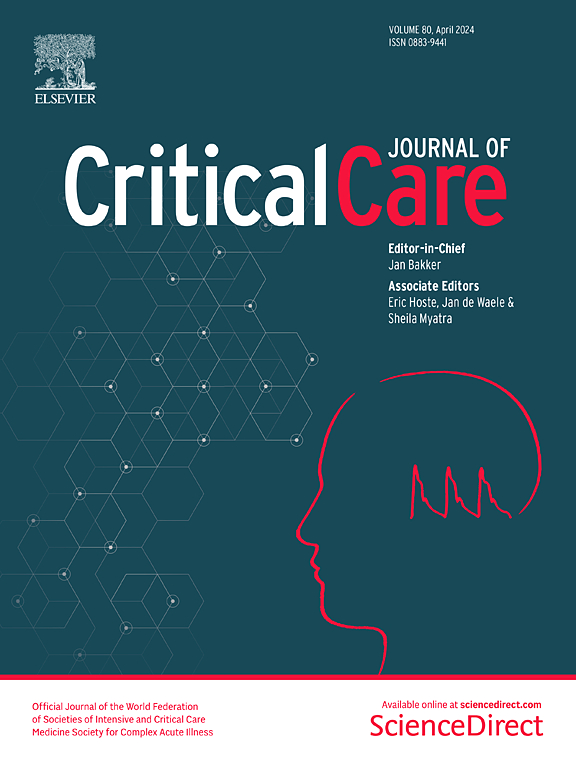Reliability of pre-admission patient-reported outcome measures postoperatively assessed via proxies: a prospective, multicenter observational study
IF 8.8
1区 医学
Q1 CRITICAL CARE MEDICINE
引用次数: 0
Abstract
Pre-admission status obtained through patient-reported outcome measures is an essential metric in both clinical and research settings for prognostication and treatment decisions. It is frequently collected by proxies, although its reliability has yet to be thoroughly investigated. The objective was to determine the reliability of proxy assessments regarding pre-ICU admission status via patient-reported outcome measures and to explore the impact of the ICU setting on these assessments. Prospective multicentre observational study in two tertiary care university hospitals in Germany, including surgical adult patients able to independently answer the patient-reported outcome measures (SF-36, EQ-5D-5L, WHODAS 2.0, IADL, and Barthel Index) with a proxy available. Patients were interviewed pre-operatively, while proxies were interviewed post-operatively in the ICU or normal ward, depending on the patient's location. The reliability of patient-reported outcome measures was analyzed using Bland–Altman plots and Cohen’s kappa. Of 204 patient-proxy pairs, 102 were admitted to an ICU. The median patient and proxy age were 69 and 64 years, with 41% and 68% female, respectively. Bland–Altman plots demonstrated insufficient reliability of proxy ratings, as the 95% limits of agreement fell outside the minimal clinically important difference (MCID) for all questionnaires. However, a significant bias was evident only among ICU patients, showing worse ratings from proxies for the WHODAS 2.0, IADL, and subsets of the SF-36. For the EQ-5D, bias appeared in both the ICU and non-ICU cohorts. The dichotomous analysis of the within-pairs-difference supported the findings, revealing a high proportion of pairs with differences outside the MCID (n (%)—SF-36 PCS normal ward: 47 (46%), ICU: 58 (57%); SF-36 MCS normal ward: 59 (58%), ICU: 62 (61%); WHODAS 2.0 normal ward: 58 (57%), ICU: 78 (77%); EQ-5D-5L normal ward: 40 (39%), ICU: 46 (45%); Barthel-Index normal ward: 22 (22%), ICU: 21 (21%)). Cohen’s kappa indicated moderate reliability for the IADL. The reliability of proxy assessment with the instruments used was insufficient, exhibiting a significant bias in the pre-admission status of ICU patients; therefore, it should be applied with caution. Trial registration: ClinicalTrials.gov (NCT03785444—28th of December 2018).通过代理评估入院前患者报告的术后结果测量的可靠性:一项前瞻性、多中心观察性研究
通过患者报告的结果测量获得的入院前状态是临床和研究环境中预测和治疗决策的基本指标。它经常由代理收集,尽管其可靠性尚未得到彻底调查。目的是通过患者报告的结果测量来确定关于ICU前入院状态的代理评估的可靠性,并探讨ICU环境对这些评估的影响。前瞻性多中心观察研究在德国的两所三级护理大学医院进行,包括能够独立回答患者报告的结果测量(SF-36、EQ-5D-5L、WHODAS 2.0、IADL和Barthel指数)的外科成年患者,并有一个可用的代理。患者术前接受访谈,而代理人则在ICU或普通病房进行术后访谈,具体取决于患者的位置。采用Bland-Altman图和Cohen’s kappa分析患者报告结果测量的可靠性。在204对患者-代理中,102对入住ICU。中位患者和代理年龄分别为69岁和64岁,女性分别占41%和68%。Bland-Altman图显示代理评分的可靠性不足,因为95%的一致性限制超出了所有问卷的最小临床重要差异(MCID)。然而,仅在ICU患者中存在明显的偏倚,WHODAS 2.0、IADL和SF-36亚群的代理评分较差。对于EQ-5D,在ICU和非ICU队列中均出现偏倚。对配对内差异的二分类分析支持了这一发现,显示MCID以外存在差异的配对比例很高(n (%) -SF-36 PCS正常病房:47 (46%),ICU: 58 (57%);SF-36 MCS正常病房59例(58%),ICU 62例(61%);WHODAS 2.0普通病房58例(57%),ICU 78例(77%);EQ-5D-5L普通病房:40例(39%),ICU: 46例(45%);正常病房:22 (22%),ICU: 21(21%)。Cohen’s kappa显示IADL的信度中等。使用的工具进行代理评估的可靠性不足,对ICU患者的入院前状态存在显著偏差;因此,应谨慎使用。试验注册:ClinicalTrials.gov (nct03785444 - 2018年12月28日)。
本文章由计算机程序翻译,如有差异,请以英文原文为准。
求助全文
约1分钟内获得全文
求助全文
来源期刊

Critical Care
医学-危重病医学
CiteScore
20.60
自引率
3.30%
发文量
348
审稿时长
1.5 months
期刊介绍:
Critical Care is an esteemed international medical journal that undergoes a rigorous peer-review process to maintain its high quality standards. Its primary objective is to enhance the healthcare services offered to critically ill patients. To achieve this, the journal focuses on gathering, exchanging, disseminating, and endorsing evidence-based information that is highly relevant to intensivists. By doing so, Critical Care seeks to provide a thorough and inclusive examination of the intensive care field.
 求助内容:
求助内容: 应助结果提醒方式:
应助结果提醒方式:


